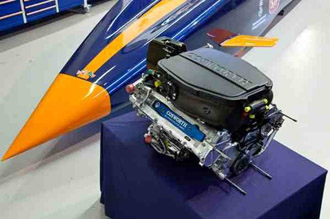|
SAASTA takes on the Bloodhound project to inspire SA's youth Bloodhound SSC (Supersonic Car) is a jet-and-rocket-powered car that will attempt to break the current land speed record of 1,228 km/h by approximately 30%, to just over 1,600 km/h, at Hakskeenpan in the Northern Cape in 2015. The car, currently being built in the UK, will arrive in South Africa this year for a series of test runs at speeds of up to 1,300 km/h.
Remarkable engineering Bloodhound SSC is the result of remarkable engineering that will allow this ultimate racing car to travel 1,6 kilometres in just 3,6 seconds. The car weighs in at just over seven tonnes and is nearly 14 metres long. Its engine produces more than 135,000 horsepower (more than 100,000kW). That is more or less the same horsepower as 160 Formula 1 cars. As soon as the Bloodhound SSC project was launched, the search for a suitable run site (or race track) began. After two years of studying satellite images and visiting sites around the world, the perfect run site was identified: Hakskeenpan in the Northern Cape. Supported by the Northern Cape Provincial Government, the local community has almost completed the enormous task of preparing the track. So far, about 300 members of the Mier community have cleared 6,000 tonnes of stones and rocks from the 1,1km wide and 20km long stretch of desert. Over 250 UK companies, 180 of them SMEs, are involved in the Project, which has become a showcase for science and engineering capability with the first South African companies now engaged with the engineering adventure as product sponsors. The communications technology to enable the HD camera transmission and the upload of 300 data channels from the car, whilst travelling at 1 600km/h, has been developed by South African companies MTN, Poynting Antennas and Emcom. This vital development work will enable people all over the world to see Bloodhound SSC run in virtual real time via the internet. Sharing the excitement Breaking the world land speed record is not the main goal of the Bloodhound SSC project. The key objective is inspiring the next generation of scientists and engineers by sharing the excitement of this engineering adventure and engaging educators and families. This fits in with the DST's Youth into Science strategy to build a pipeline of engineers, researchers and scientist. In this regard, the project is sharing the research, data, design, manufacturing and testing for the car with as many educators, learners and students as possible around the world, but with a focus on South Africa and the UK. The Department of Science and Technology recognised the need to support the engagement with the media and the educational and outreach activities of the science and engineering associated with the project, and commissioned SAASTA to become involved in these aspects of Bloodhound SSC. The project is already generating global public and media interest, and millions of people are expected to watch the supersonic test runs and record attempt in real time, with many visitors coming to South Africa and Hakskeenpan. The event also presents a special opportunity to engage and inspire South Africa's youth about the potential and excitement of cutting-edge science and engineering. For SAASTA and the NRF it presents an opportunity to add further substance to our mandate of advancing science, and identifying and nurturing talent among South African youth. Bloodhound team The Bloodhound education team in South Africa is already busy with an ongoing project of visiting schools, focusing particularly on the Northern Cape, to inspire learners and educators to use the Project's free educational resources to make science, maths and engineering come alive in the classroom. Since August 2011, the SA education team (consisting of only two people based in Kimberley and supported by 12 Ambassadors) have visited over 100 schools in South Africa (38 of them in the Northern Cape Province) with Bloodhound SSC talks and workshops. To date, 532 schools in South Africa (92 in the Northern Cape) have registered as participating schools. Their first visit was to Hakskeenpan and the first schools registered were Groot Mier Primary and Rietfontein High School. Dave Rowley, Bloodhound SSC education director for South Africa, estimates that the project has introduced 108 000 learners to the project, with around one third of them in the Northern Cape. His target is to register 1 000 schools by the end of 2014 (with at least 300 of them in the Northern Cape). Dave and his team have already participated in Scifest Africa (since 2011), National Science Week (since 2011), One Young World, AfricaCom, Top gear Festival and many more. Here is what you can look forward to from the Bloodhound SSC project:
And much more ... For more information on this exciting project and its endless scientific opportunities, please contact Anacletta Koloko. |



